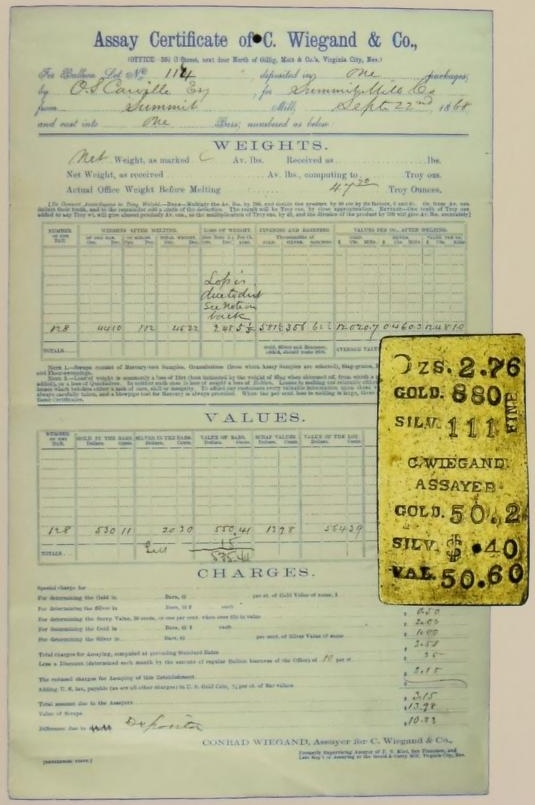As seen from Stacks 10/2007, “John J. Ford, Jr. Collection of Coins, Medals and Currency”, reshared here for reference in ties with other Wiegand ingots:
Persons and companies depositing bullion with a U.S. branch mint or private assayer received an acknowledgment of the transaction on its completion, commonly called an assay receipt. These receipts typically describe the type of bullion deposited, its weight, and the results and costs attached to the subsequent assay. Mint returns were ordinarily made in the form of coin but bars could also be requested. Bullion deposits to mints ordinarily were in the form of refined but unparted bars, but there are also records of territorial gold coin being handed over for melting and assay. Private assayers typically received bullion deposits in less refined forms, such as nuggets, dust, or amalgam. Corporate and company bullion deposits were ordinarily made to their in-house assayers who received large bars to prove an assay. Some assay houses were very large enterprises handling bullion deposits bought up by bullion traders who ranged the gold fields offering to buy gold bullion on deposit with small regional banks or owned by individual miners and other bullion traders. Houses such as Justh & Hunter were located in San Francisco, near to the transshipment wharves in the city. They received numerous deposits of all sizes, amalgamated them, mixed, melted and guaranteed the assay of the resulting transport ingots.

These receipts record the names and addresses of assayers across several western states. In some cases, assay bars made by some of these assayers have survived. In others, the assayer is known only by his receipt as no bars bearing his name stamp have survived. Some receipts are small and have a minimum of data on them. Others, such as Conrad Wiegand’s, are long and somewhat wordy.
Mint memoranda of deposit of silver or gold bullion ordinarily note the deposit as made in bar form and most of these bars were fairly substantial, although smaller bars weighing under 16 or even 12 ounces are not unknown in the records. The cataloguer notes that the neologism “assay bars” should be read as synonymous with “bars” and when the latter is found on a mint bullion deposit record the former may be assumed. Any bar deposited at the western mints had already been assayed as it was in bar form. Its deposit with a mint was for the purpose of obtaining its value in coin. The mint determined the coin value of a bar by running its own assay on the bar, even if the ingot was already stamped with the assay results from a private assaying firm. A reading of “assay bar” for “bar” on a memorandum of deposit to a branch mint is a mistake. A moment’s reflection will suggest that intentional or not, such a mistake can have only terminological, not evidentiary, effect.
Collecting assay receipts is a sub-set of collecting assay ingots. Those who collect the latter always include the former and not only receipts of assayers whose bars they also own. One advantage of collecting receipts is that they are far less costly than bars and a collection of 10 or more receipts each from a different assayer and in good condition will cost a fraction of the price of one bar.
